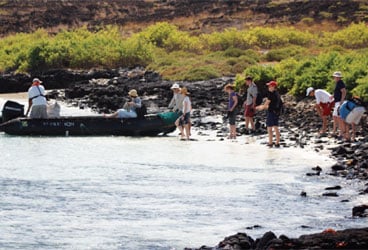
Sombrero Chino, Galápagos
Even in an early morning, bleary-eyed, jet-lagged fog, I sat up and took notice when, en route to Isla San Cristóbal, in the Galápagos, the flight attendant strode down the aisle of the plane and opened every overhead luggage compartment. In fact, I was fully alert as she walked back forward and sprayed each compartment with a pesticide before slamming shut the locker door.
We’d been forewarned, of course, not to bring food, animal, or vegetable products to the islands. But spraying our carry-on luggage? Now that’s different.
Over the course of the next few days, as we were told to clean the soles of our shoes when leaving one island to visit the next, as we swam only in designated areas, landed just on certain beaches, and were fastidious in our efforts not to stray from the well-trod paths shown to us by our pair of licensed naturalists—who double as environmental park rangers—all these precautions began to register, and these steps to minimize the impact of our visit to the archipelago came into focus. (See “A Journey Through Time” in our December 2012 issue.)
The Galápagos, after all, have quite visible scars to show what We can do. In the 1600s and 1700s, pirate ships brought rats by the boatload. In the 1800s, whalers came in droves and carried off the docile giant tortoises by the thousands to replenish their food stores. Settlers from the mainland arrived with alien plants that depleted the arid soil. They brought along cattle and cats and donkeys and dogs and goats and pigs, all of which devastated the natural balance of the islands. In more recent times, foreign-flagged fish factories scoured the reefs, and local fishermen cashed in on the demand for delicacies ranging from lobsters to sea cucumbers to shark fins.
But these islands, a UNESCO World Heritage Site and Biosphere Reserve, also reflect what 50-plus years of environmental stewardship can do to turn things around. Since 1959, the Charles Darwin Foundation has consulted with the government of Ecuador, with sustainability being the ultimate goal.
Don’t get me wrong; a visit to the Galápagos is nothing short of one astounding adventure. During our first six days in the islands, we had a ball surrounded by sea lions, frigate birds, jet-black marine iguanas, their golden land cousins, penguins, sharks (yes, sharks!), orcas, rays, and gulls. I heard so many booby jokes that there couldn’t have been one more left to tell.
But it was our last full day, a Friday, that I found to be the most thought provoking. In the morning, we visited the foundation’s science center. There, development manager Roslyn Cameron talked about island reclamation and breeding projects, programs to turn fishermen into tour and dive guides, and education. As it is everywhere, education is the key to the future. If species disappear, the reefs die, and the fish leave, then no one will come to these Galápagos—and tourism, today, accounts for more than half of the islands’ economy. Later, we visited a sustainable coffee and sugar plantation in the mountains. The owners now reap rewards both from the soil and tourists, and they’ve preserved a tree-covered flyway for migratory birds. That’s education at work.
Sailing green, living green—it all takes work. That’s a lesson well learned in the Galápagos Islands.
Mark Pillsbury
Click here to read more from Mark Pillsbury.







